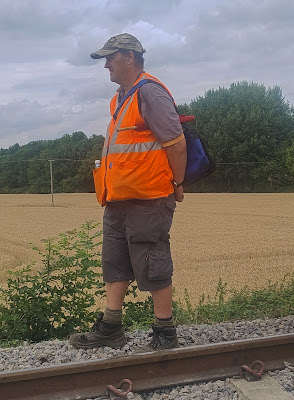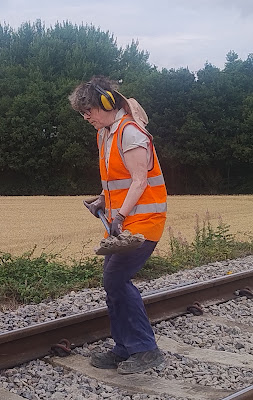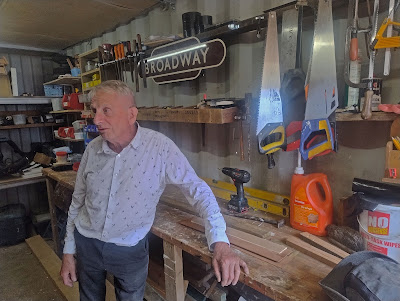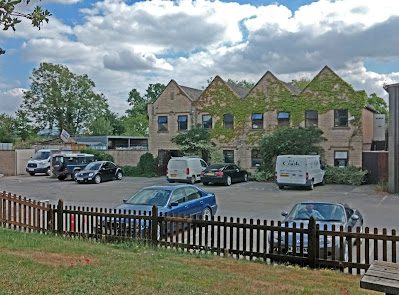The special bricks saga.
All of the bricks used on P2 at Broadway were ordered about 10 years ago, in anticipation of building the waiting room that never came, until the canopy gang took it on.
The bricks were ordered from a supplier some distance away. We think we have enough plain stretchers, but are short of 4 types of the specials, notably those at the base and sides of the windows, where square bricks convert into a round column. It has taken three months to be provided with a sample that was not the right shade, and finally the information that:
- The kiln that fired our original specials is closed down.
- A replacement kiln won't operate until 2026 at the earliest.
- It is not known if the new kiln will handle specials, nor what the colour and finish will be then.
Such a reply after 10 years is not entirely surprising, but the frustration in the team is that it took so long to get. We have lost 3 months, and we will just have to double up to get all the bricks laid before the roof structures is lifted in, at the end of the current operating season.
The better news is that we have approached a local brickworks, and early indications are that they can make us the specials that we need, in a shade that comes close to what we had. We must accept that we will never get an exact match, as the original kiln has closed down.
We are about to receive a box of sample bricks, from which we can make the final selection, and, after payment - it won't be cheap - the production delay, including a carpenter making one off moulds, is 6 to 8 weeks. Not too bad, in the circumstances.
So we are now hopeful that the bricks impasse has been resolved.
Wednesday, without the Usketeers.
Your blogger spent Monday to Wednesday in Southwest Wales, so the Usketeers were left alone to play.
They decided to make a gate for the top corner of the building, as it was felt that the neighbour's dog could escape from their garden that way.
The style in which Paul made it was the same as that for the adjoining fence, which the neighbour had recently renewed. The gate was attached to the fence corner post, only the hook is attached to the building itself.
Paul made a very neat job, as you can see.
The passage left around the building when the adjoining land was sold in the 1980s is extremely narrow, barely a boot wide. It's almost impossible to walk in there.
The FoWS and Yours Truly treated and removed several brambles that had started from the area as well. We don't want a big knot of spikey brambles to make it even more difficult.
Afterwards Paul and Dave treated themselves to a ride on the train, seen here at CRC.
Next week - setting out the ACO drain.
We also have a little question.
When the old Building & Services shed was knocked down in the yard at Winchcombe, and old reciprocating electric saw was revealed in the corner
It hasn't been touched in years; mechanical condition therefore unknown.
Andy, our PWay man who saws and prepares our rail ends for sale, has raised several £000s for our tool fund that way. However, he frequently has to bother someone in the steam dept to have particular bits cut to size. He wonders if there is anyone out there who would like to take the old saw on, and make it functioning and electrically safe? Then Andy and his rail end business could be independent.
If you think you'd like to help, get in touch via the blog.
A look over the fence - Welland Steam Fair.
The GWR Trust (our supporting charity) had a stand at the Welland Steam Fair over Friday to Sunday. Yours Truly was part of the Sunday crew.
We had never been to Welland before. The site was huge; the visibilty low.... not only from the hundreds of traction engines there, but from the dust pounded up by heavy lorries, motorbikes, tractors, steam engines and a tank going round. We came home with shoes that looked as if we'd taken a stroll in the sahara desert.Well, better than three days of constant rain.
 |
| Wanna volunteer? John tells it like it is. |
We had a well equipped gazebo, but there was little of real interest to the enthusiast, just tables with flyers about the railway, the viaduct, the Cotswolds Halt, the trust, legacies, young volunteering. All the right stuff, you'd say, but was it interesting?
What saved us was a very generous donation of die cast toy vehicles, many in their original boxes, which we were allowed to sell for anything that we could get for them. This made passing punters stop and look, whereupon we could engage them in conversation. We took £140 on the Friday (Saturday not recalled) and on the Sunday we took £177, with quite a few items still in stock. We felt very pleased with this rather unexpected extra income, and it made all our hard work of lugging the kit around and setting up so much more worthwhile.
As we can't rely on spontaneous kind donations of stock for sale, it would be an idea next year - we will surely be there again, last weekend in July - to bring other items for sale from the trust's bric-a-brac collection. Anything to put on tables outside, to catch the eye, and start a conversation.
The show ground was basically a farm, a short distance from the Malverns, which you can see quite close by in this picture.
There was a splendid collection of motorbikes, many of which later went round the arena.
Except this one - maybe too nice? It was a stunning Vincent HRD, polished to within an inch of its life.
What a fabulous motorbike.
Nearby was a genuine standard gauge railway. It was laid with military rail, and looked as if it had been there more than one season.
A locomotive and a converted goods van were giving rides to about a quarter of a mile away. The locomotive was HAWARDEN, a 1940 Bagnall 0-4-0, currently at the Foxfield railway, and a good advertisement for them.
Every now and then it need more coal, and this was loaded by hand from plastic bags.
Occasionally there would be an opportunity for members of our team to see the sights, and during one of these exploratory trips we had a conversation with Neil Jones here, a free miner from the Forest of Dean. He stood by an impressive pile of freshly mined coal at his feet.
Why didn't the Forest of Dean free miners supply the British heritage railway industry with coal, as we were crying out for it, and importing from Colombia, 5500 miles away?
The answer seems to be that they are too small in number, and wouldn't be able to satisfy the demand. Which is a shame, as it would have fitted so beautifully.
The arena, near to the GWRT gazebo, regularly held displays of interesting vehicles, by group.
The first group was about heavy haulers.
This one is the famous Diamond T, one of the heavy tank transporters.
One of our members - Ivor Dixon - used to drive these:
https://www.flickr.com/photos/73536293@N02/27033528989/in/album-72157688740063491
Another tank transporter was the mighty Thorneycroft ANTAR, which Ivor also drove in the army:
https://www.flickr.com/photos/73536293@N02/38092975934/in/album-72157688740063491
You can see the start of the dustbath that these circulating heavies started to throw up.
A lighter moment was provided by steam:
This was an actual steam car - we don't know the make - which hissed by, with a cloud of steam emerging underneath.
Opposite our gazebo was a rather nice road roller, not too polished up.
This was an Aveling & Porter, from Rochester in Kent, works no 7857.
It was built in 1912.
Its crew were relaxing at the back end.
Another Aveling & Porter nearby, no 8471 of 1914, is getting a bit more polish. This one's a 2cyl compound, and has a very large and loud whistle (we can testify). Is it off a steam locomotive?
There was a fascinating area of militaria as well.
The bulk of this immaculate Scammell impressed us. We think it's an Explorer, from the 1950s.
At the other end of the scale was this lovely first world war vehicle from the US:
It's a LOCOMOBILE, with solid tyres and wooden spokes! It was produced in 1913.
The number of traction engines attending the rally was amazing (didn't have time to check out the funfair, which had its own row of showman's engines, and an 'electric boat' ).
Here is a selection:
This one was working a sawmill. It was in beautiful condition, with a lovely steady beat.
This was a 1909 Foster 'Old Smokey', giving rides around the grounds.
This was a big one, weighing in at 14 tons.
It was built in 1920, and is named 'ROB ROY'.
It's a twin cylinder compound.
As this was a steam rally there were no cars - except this immaculate Ford model T.
The day as a volunteer in the green GWRT gazebo (top right) was not 'all work, and no play'.
Providing there was cover, we could take half an hour off here and there, and even buy a round of ice creams!
This is a well known volunteer from the steam dept at Toddington, Theresa.
Hurry up, before they melt!
There was even a traditional Punch & Judy show, with lots of children watching.
'Im just going to go downstairs and tidy up my bedroom. You all enjoy doing that, don't you?'
' Noooooooo !!! '
The Welland site is vast, a whole farm's worth of fields.
This gives you a small idea of what area it covers. The field was used for demonstrations of ploughing etc, and also for the work of construction machinery to one side
Here's plodding Field Marshall raking the earth, which was being ploughed up again by a massive Caterpillar tractor just off camera.
Temporarily paused was the lower partner of a pair of ploughing engines, equipped with a big winding drum underneath.
This pulls a plough, or as here a harrow, back and forth across a large field.
We also missed out on a gun battle between troops of two different WW2 armies.
It all looked very realistic. This German trench had a machine gun, a Kettenkrad, a derailed wagon and a short stretch of twisted track, apparently hit by a bomb.
In the construction machinery area holes were being dug all day long, as here with an old fashioned dragline and a ten wheeler. It was interesting to see how the bucket was manoeuvered by means of ropes and gravity.
At the end of the day it was all filled in again, ready for next year.
On a smaller scale was this narrow gauge line, also a permanent fixture by the look of it, which ran alongside a road that was being rolled with a steam roller.
The hillside also saw another sawmill, this one equipped with an additional engine and crane ( a Ransomes), to lift the heavy logs into place.
The saw bench and its huge, menacing saw blade was called 'The Rippitt', rather appropriately, we thought.
For us the best part of the day came as we were breaking down the gazebo, when we suddenly heard a sputtering roar from the main arena neaby.
We don't have a picture, but there is a film:
It shows a Chieftain (Centurion?) based Armoured Recovery Vehicle (a tank without a turret) with a badly tuned engine crushing two cars that had strayed into the main arena.
It's what you get, if you don't follow the marshalls...
We can't say much about the ARV, except that it was called 'DAVE', and, we heard, got itself stuck down a deep trench earlier (it was a three day event), much to the glee of those operating heavy recovery vehicles.
And finally:
The RATs trust had a largeish black plastic box behind their sales shed at Toddington. It was recently obtained (at a cost!) and was meant to house donated articles for sale, a sort of buffer stock.
But after just a couple of weeks behind the RATs shed it vanished.
Has anyone reading this taken it, thinking it wasn't being used? Please give it back !



































































